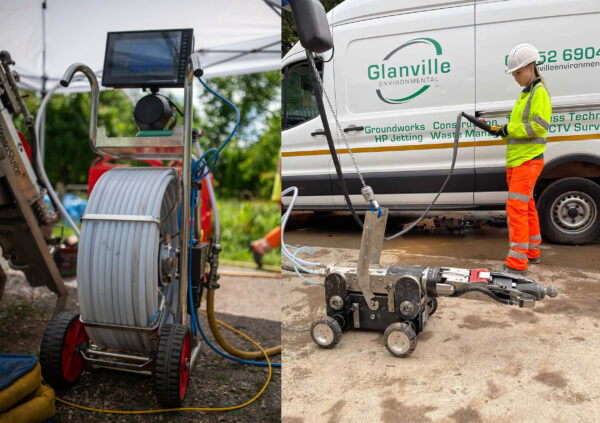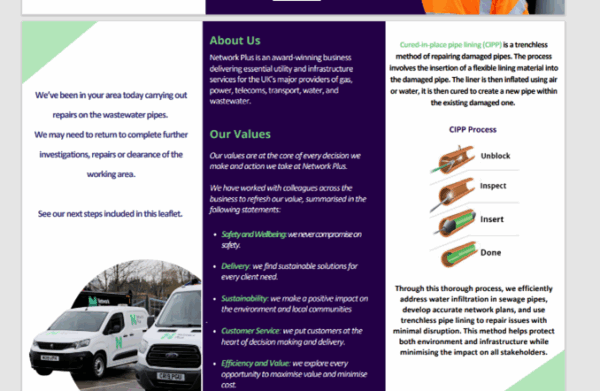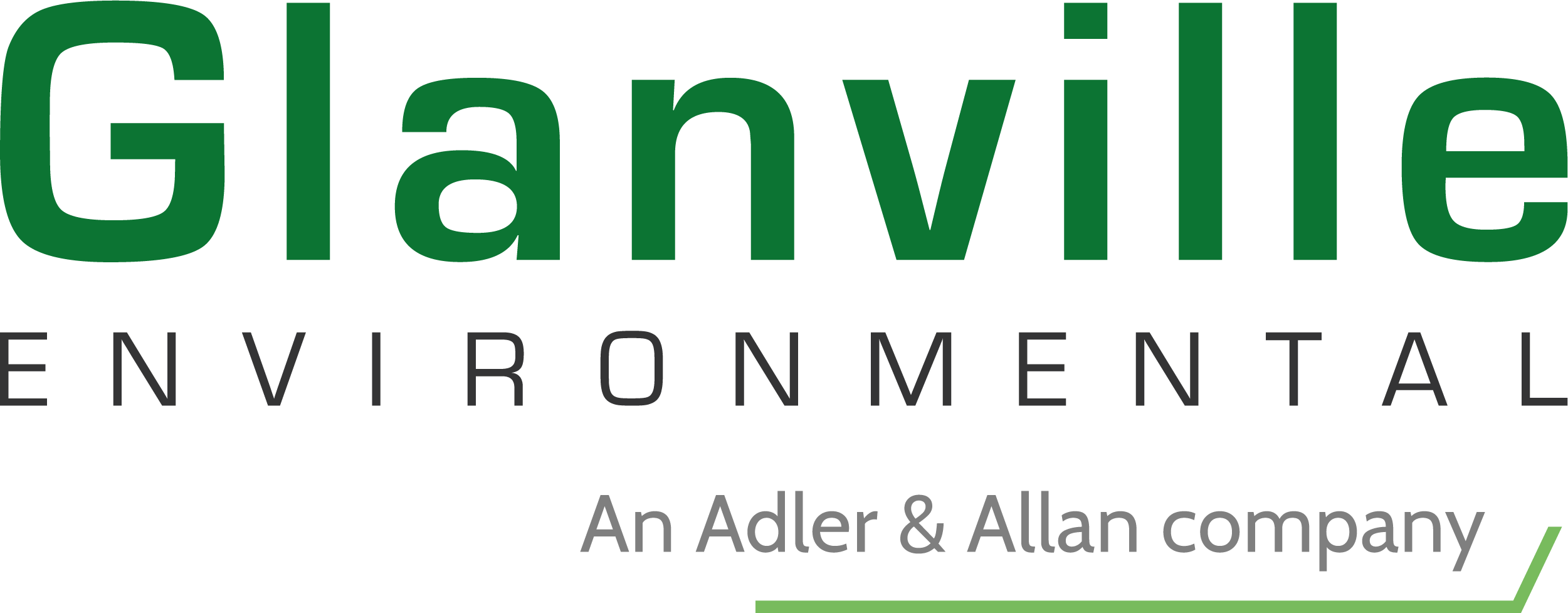Infiltration Reduction Programme
Infiltration Reduction Programme – South West Water & Glanville Environmental & Network Plus
Project Summary
South West Water’s £16m Infiltration Reduction Programme is the largest sewer rehabilitation scheme in its history, targeting the reduction of storm overflow across 175 high-risk sites. Delivered collaboratively with Glanville Environmental and Network Plus, the programme used advanced CCTV, AI diagnostics, and trenchless technologies to prevent over 4,800 spills in 2024 alone. Over 50km of sewer lining and 2,000 manhole rehabilitations were completed with minimal disruption. A data-led, sustainable approach enabled agile deployment and real-time decision-making. This innovative, multi-partner model has set a new national standard for large-scale sewer infrastructure renewal, delivering measurable environmental improvements across coastal and inland water catchments.
Project Overview
In late 2023, South West Water (SWW) launched the largest sewer rehabilitation programme in its history, aiming to reduce infiltration and cut storm overflow events on a major scale. The goal was clear: protect the environment, maintain public confidence, and reduce sewer spills by targeting infiltration at 175 critical overflows across SWW’s 23,000km wastewater network.
SWW is responsible for more than 1,384km of coastline and 157 bathing waters, over a third of the UK’s designated sites, making fast, visible action essential as scrutiny from regulators and the public grows.
This ambitious £16m infiltration reduction programme was delivered rapidly across 184 individual projects, using trenchless methods to maximise output despite challenging hydrological conditions. Partnering with eight trenchless contractors, including Glanville Environmental and Network Plus, the team used advanced surveying, analysis, and repair techniques to deliver consistent results across the region.
The programme delivered a measurable environmental impact, preventing an estimated 4,800 storm spills in 2024 alone, the wettest year on record. Notably, three-quarters of SWW’s top 20 worst-spilling overflows were removed from the 2023 list. The scale and success of this collaborative approach redefined what’s possible in infiltration reduction.

Project Management
Delivering a multi-million-pound programme across 175 live sewer overflows demanded tight coordination and agile delivery. A benchmarking exercise identified the highest-priority targets from over 1,600 overflows, focusing resources where spill reduction would be most effective. SWW and partners tracked performance using shared IT tools and KPIs across all projects.
At its peak, more than 30 CCTV teams from eight contractors, including Glanville’s CCTV and Trenchless Divisions and Network Plus’ supply chain, were deployed. Coordination between partners ensured consistency in safety, methodology, and data quality.
The collaborative structure allowed trusted partners like Glanville to work autonomously within a unified framework, avoiding overlap. Network Plus expanded local capabilities, investing in training and equipment while tailoring delivery to regional needs.
Ground conditions, location type, seasonal demands, and upstream flows were analysed for catchments. Local knowledge guided the use of CCTV where it mattered most, while ‘lift and look’ inspections helped quickly rule out low-risk areas. This mobile, agile strategy improved infiltration detection rates and team productivity.
In large catchments previously affected by mass infiltration, initial surveys were followed by rehabilitation and re-surveys. This phased approach revealed remaining issues previously masked by high flows and ensured long-term effectiveness.
Despite the scale, quality and safety were never compromised. Over 240,000 metres of CCTV survey data were reviewed, 50.5km of liners were installed, and more than 2,000 manholes were rehabilitated, within budget, on time, and to a high standard.

Community Impact & Customer Care
With hundreds of localities affected, minimising disruption was essential. Trenchless techniques like UV lining, ambient patching, and spray-coating allowed work to proceed with minimal road closures, reduced noise, and continued access for the public.
Communications were proactive and tailored. Each site received advance notice, and stakeholder teams engaged directly with councils and residents, especially in coastal or sensitive areas.
Targeted surveying further reduced disruption. By inspecting only key locations and avoiding unnecessary excavation, site teams spent less time in each area. Their mobile, responsive setup allowed for fast, efficient work without prolonged presence.
Because work was proactive, not reactive, residents and businesses were spared lengthy unplanned repairs. The programme’s visible impact on storm spills also helped restore public trust and strengthen SWW’s reputation for environmental responsibility.
Legislative Compliance
Operating across hundreds of live sewer assets required strict compliance with safety and legal standards. All work was delivered under CDM 2015 regulations, with principal contractors appointed based on risk and task complexity.
Health and safety were embedded into every part of delivery, including confined space protocols, chemical handling procedures, and risk assessments. UV and ambient curing operations were closely controlled, and all lining materials met industry regulations.
Thanks to the trenchless approach, most work avoided excavation. Where street permits were needed, early engagement with highways teams kept disruption and risk low, supporting a strong safety record across the programme.
Sustainability
Environmental protection was a core objective. Every overflow prevented means cleaner rivers and seas. With responsibility for 157 bathing waters, SWW prioritised sustainability throughout the programme.
Trenchless methods helped avoid surface disruption, reduce waste, and lower emissions. Over 50.5km of sewer lining and 1,400 patch repairs were completed without excavation. The rehabilitation of 2,000 manholes further extended asset life, reducing future resource needs.
AI-supported CCTV analysis helped cut emissions by reducing repeat visits and speeding up decision-making. This digital-first approach saved time, fuel, and materials, reinforcing a low-carbon delivery model that aligned with partner sustainability goals.
Public engagement also supported the programme’s green credentials. Educational leaflets, signage, and community consultations helped explain trenchless technology and its environmental benefits, building awareness and cooperation in affected areas.

Innovation
This programme broke new ground in both scale and delivery method. Rather than relying solely on traditional inspection and repair cycles, the team used artificial intelligence to speed up CCTV analysis, identify priority defects, and generate faster rehabilitation plans.
AI interpretation improved field productivity and decision-making. Real-time data and performance dashboards enabled quick resourcing adjustments, reduced duplication, and streamlined reporting.
Innovation extended to the range of trenchless techniques used. UV lining, ambient patching, robotic cutting, and manhole spray lining were selected based on site-specific needs, avoiding a one-size-fits-all approach and ensuring better value and performance.
Just as significant was the collaborative model. Coordinating multiple trenchless providers across 184 projects showed how industry partnerships can deliver national-scale infrastructure upgrades under regulatory pressure. It’s a blueprint for future delivery across the UK water sector.
We are very excited and proud that this project has since been nominated at the Utility Awards in London on December 2nd. Watch this space for the results!
For more information, please contact:
Marketing & Communications Team
communications@glanvilleltd.co.uk
